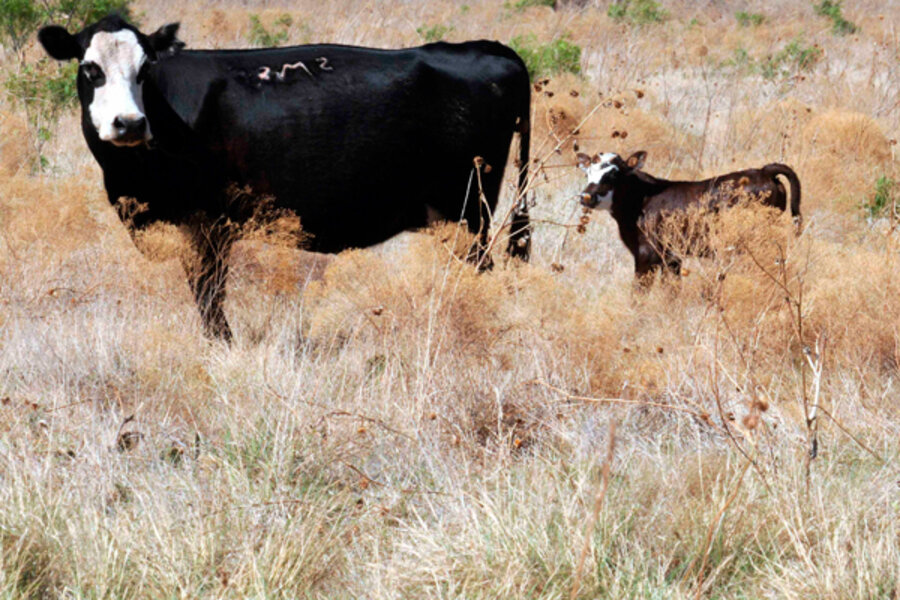South's 'extreme drought' could be felt at supermarkets soon
Loading...
| Little Rock, Ark.
The extreme drought conditions throughout the South and as far west as California that stoked record-setting wildfires are increasingly taking their toll on cattle ranchers, a development that could lead to sticker shock at grocery stores in the fall.
With grassland pastures dying and feed prohibitively expensive for many ranchers, huge stocks of cattle are being sold off, setting up a shortage that could dramatically drive up the price of beef for months or even years.
“If you like steak and cheap, good ones, now is the time to eat them,” says John Michael Riley, an extension agricultural economist at Mississippi State University in Starkville. “What it is going to mean is the long run is that there will be a shortage on beef or cattle. This the start of something that we could see for a number of years.”
The National Weather Service has declared many areas of the United States to be in an “exceptional drought” with above-average temperatures and no relief in sight. Ranchers in Texas, the country’s largest producer of cattle, have been dealing with dire conditions since early spring, when many unloaded their cattle and saturated the market.
Now, that trend is spreading to other states.
Arkansas cattle farmer Kenny Simon acknowledges that he has to think strategically about grass and hay these days.
Simon’s cattle graze on a 130-acre pasture, which is dying from extremely dry conditions. His hay stock is low because of an unusually long, cold winter. Every few days, Simon has to rotate the cattle through the pastures so they graze on better foliage.
It’s certainly not business as usual for Mr. Simon, a third-generation farmer.
“I’ve already been forced to sell some calves before I had planned because there was simply not enough grass for them,” says Simon. “I have pastures that look brown with no re-growth. It’s becoming a real challenge.”
More than 95 percent of Arkansas is currently under a drought classification. The Texas sell-off this spring means fewer cattle are on the market, so ranchers in Arkansas and other states who need to sell to avoid high feed costs are getting good prices.
But the impact from diminished stocks could have a long-term impact. While northern cattle-producing states like Nebraska and the Dakotas have yet to reach drought conditions, farmers there can’t immediately take up the slack in the market. It takes time for cows to become mature enough to sell.
Raising cattle for profit is a three-year process, says Mr. Riley. A heifer can’t breed a calf until she is 2 years old. Then it’s another year before that calf can be sold and harvested.
It’s not just cattle farmers who are worried. Hay harvesters are pondering their bottom line, too. In 2010, Arkansas harvested 1.48 million acres of hay. Some sell bales to Texas and other states. Growers who do cut hay find that what’s left in the field is dying quickly.
“Talking to producers lately has revealed most had about 75 percent of normal yield their first hay cutting, and the second cutting is less than half of normal yields if they were even able to cut a second harvest,” says Joe Vestal, an extension staff chair for the University of Arkansas Division of Agriculture.
Arkansas hay transporters are receiving calls from Texas and Oklahoma cattle producers who need hay. They have none to deliver. Some hay growers are also finding themselves in an unusual predicament. Some made agreements last winter to sell hay to others, but are now wishing they could keep it for their own uses.
Simon’s family has been farming since 1936, and he only harvests hay for his own cattle with his grandfather’s equipment. He doesn’t sell his bales. This year’s hay harvest was down by 30 percent. In early August, Simon plans to fertilize his pasture and hopes to yield enough hay for 2012.
But he isn’t particularly optimistic.
“I need safely another 40 bales to make it through the winter,” he says. “If the drought continues, I am not sure I can get that.”





